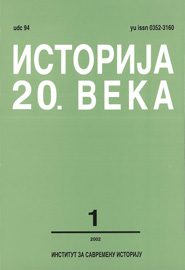ПРИВАТНИ НОВЧАНИ ЗАВОДИ И БАНКАРСТВО У ЛЕСКОВЦУ ИЗМЕЂУ ДВА СВЕТСКА РАТА
PRIVATE MONEY INSTITUTIONS AND BANKING IN LESKOVAC BETWEEN THE TWO WORLD WARS
Author(s): Ivan M. BecićSubject(s): Economic history, Recent History (1900 till today), Interwar Period (1920 - 1939), Financial Markets
Published by: Institut za savremenu istoriju, Beograd
Keywords: Serbia; Leskovac; interwar period; private money institutions; banking; trade;
Summary/Abstract: Between the two world wars, Leskovac was one of the few industrial centers in the prewar region of the Kingdom of Serbia. A strong industry (mainly textile) required adequate money institutions to support its activity. On the other hand, the people who stood behind the leading industrial capital used every opportunity to grasp control of the financial movements in the south of the country. Banking in Leskovac entered a period of rapid progress in the course of the twenties, while instability resulting from the economic crisis and the state’s inability to fully control the banks caused a drop in the thirties. The banks did not engage solely in financial transactions but were also involved in trade, civil engineering, projects dealing with power supply, etc. On the eve of World War II the town had seven banks: the Central Bank, Commercial Bank, Trade Bank, General Bank, the Leskovac Cooperative, the Leskovac Savings Bank, and the Cooperative Bank. These banks’ total capital was considerably greater than in other towns of Serbia.
Journal: Istorija 20. veka
- Issue Year: 2002
- Issue No: 1
- Page Range: 133-143
- Page Count: 11
- Language: Serbian

